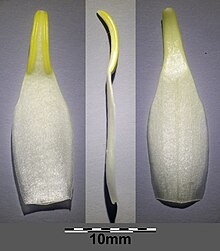| Nymphaea subg. Nymphaea | |
|---|---|

| |
| Botanical illustration of Nymphaea alba | |
| Scientific classification | |
| Kingdom: | Plantae |
| Clade: | Tracheophytes |
| Clade: | Angiosperms |
| Order: | Nymphaeales |
| Family: | Nymphaeaceae |
| Genus: | Nymphaea |
| Subgenus: | Nymphaea subg. Nymphaea |
| Type species | |
| Nymphaea alba L. | |
| Sections | |
| |
| Synonyms | |
| |
Nymphaea subg. Nymphaea is a subgenus of the genus Nymphaea.
Description

 Adaxial leaf surface of Nymphaea odorata subsp. tuberosa
Adaxial leaf surface of Nymphaea odorata subsp. tuberosa
 Abaxial leaf surface of Nymphaea odorata subsp. tuberosa
Abaxial leaf surface of Nymphaea odorata subsp. tuberosa
Vegetative characteristics
Species of Nymphaea subg. Nymphaea have horizontal or vertical rhizomes. The leaf margins are entire, sinuate or crenate, but never dentate.
Generative characteristics
The diurnal flowers float on the water surface. The outer stamens have petaloid filaments. The stamens do not have a sterile appendage at the apex. The carpellary styles are ligulate. The petals are predominantly white, but pink, red, and yellow colouration occurs as well. The large seeds have a smooth surface.
Taxonomy
The subgenus Nymphaea subg. Nymphaea is an autonym. The type species is Nymphaea alba L.
Sections
It is divided into three sections:
- Nymphaea sect. Chamaenymphaea (Planch.) Wiersema
- Nymphaea sect. Nymphaea (autonym)
- Nymphaea sect. Xanthantha (Casp.) Wiersema
Species
- Nymphaea alba L.
- Nymphaea candida C.Presl
- Nymphaea leibergii (Morong) Rydb.
- Nymphaea loriana Wiersema, Hellq. & Borsch
- Nymphaea mexicana Zucc.
- Nymphaea odorata Aiton
- Nymphaea pygmaea (Salisb.) W.T. Aiton
- Nymphaea × sundvikii Hiitonen
- Nymphaea tetragona Georgi
- Nymphaea × thiona D.B.Ward
Distribution
Nymphaea subg. Nymphaea occurs in the temperate regions of the Northern Hemisphere.
References
- ^ Nymphaea subg. Nymphaea. (2020, January 6). Wikispecies. Retrieved 19:38, January 23, 2024 from https://species.wikimedia.org/search/?title=Nymphaea_subg._Nymphaea&oldid=7207897.
- ^ Nymphaea nymphaea GRIN-Global. (n.d.). U.S. National Plant Germplasm System. Retrieved January 23, 2024, from https://npgsweb.ars-grin.gov/gringlobal/taxon/taxonomygenus?type=subgenus&id=18563
- ^ Borsch, T., Hilu, K. W., Wiersema, J. H., Löhne, C., Barthlott, W., & Wilde, V. (2007). "Phylogeny of Nymphaea (Nymphaeaceae): evidence from substitutions and microstructural changes in the chloroplast trnT-trnF region." International Journal of Plant Sciences, 168(5), 639-671.
- ^ null. Nymphaea subg. Nymphaea, in (ed.), Flora of Australia. Australian Biological Resources Study, Department of Climate Change, Energy, the Environment and Water: Canberra. https://profiles.ala.org.au/opus/foa/profile/Nymphaea%20subg.%20Nymphaea
- ^ Wood, Carroll E. (1959). The Genera of the Nymphaeaceae and Ceratophyllaceae in the Southeastern United States. Journal of the Arnold Arboretum, 40, 94–112. Retrieved from https://www.biodiversitylibrary.org/part/324659
- ^ Flora of New Zealand | Taxon Profile | Nymphaea. (n.d.). Retrieved February 3, 2024, from https://www.nzflora.info/factsheet/taxon/Nymphaea.html
- Nymphaea subg. Nymphaea. (n.d.). The Australian National Species List (auNSL). Retrieved December 3, 2024, from https://biodiversity.org.au/nsl/services/rest/name/apni/212035
- ^ Löhne, C., Yoo, M. J., Borsch, T., Wiersema, J., Wilde, V., Bell, C. D., ... & Soltis, P. S. (2008). Biogeography of Nymphaeales: extant patterns and historical events. Taxon, 57(4), 1123-19E.
| Taxon identifiers | |
|---|---|
| Nymphaea subg. Nymphaea | |